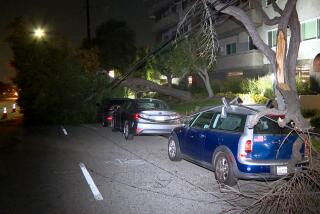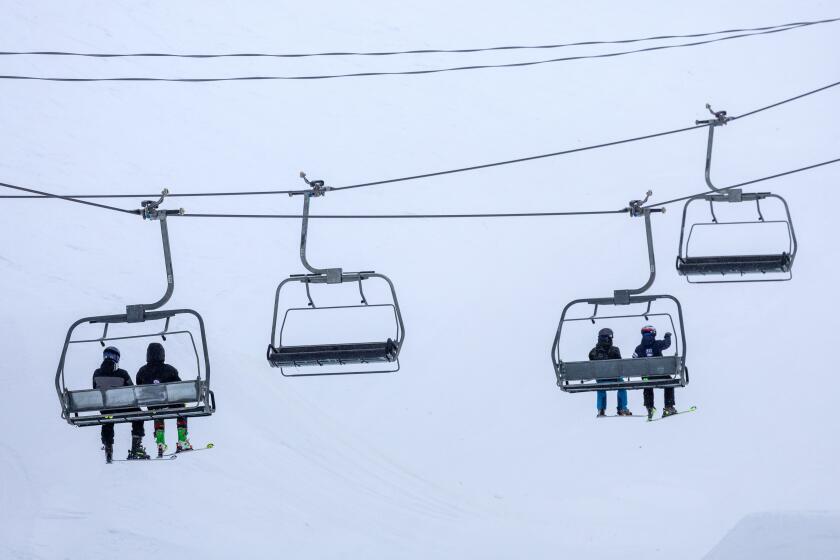High Winds Rage Across Southland
- Share via
Powerful Santa Ana winds gusting to 70 mph Monday fanned fires that destroyed two homes, delayed two dozen flights at Burbank’s Bob Hope Airport and left more than 100,000 people without power.
Forecasters, who predict that the winds will continue into this evening, said Southern California is under the influence of a developing La Nina, a weather condition that would mean a drier than normal winter.
The winds and low humidity prompted the National Weather Service to call a red flag warning for fire danger, and firefighters said they were particularly concerned about brush fires because the gusts were so strong in some areas that water-dropping helicopters could not be deployed.
“Helicopters are not effective with winds blowing 60 mph with gusts of 70,” said Los Angeles County Fire Capt. Mark Savage. “It would be extremely dangerous to fly in those conditions in the daytime, let alone at night and in the canyons.”
The winds littered roadways with debris, causing pedestrians to duck and drivers to swerve. Flames were blown dangerously close to foothill neighborhoods.
A wind-driven fire on the sloping Fairgrove Avenue in Tujunga destroyed a house and a motor home and damaged four other residences. A fallen power line in La Canada Flintridge caused an eight-acre blaze that was attacked by about 200 firefighters, and authorities dealt with several big rigs that may have been overturned by gusts.
The winds prompted long delays at Bob Hope Airport, prompting some passengers to reroute to other airfields. More than two dozen departures and arrivals were canceled at the airport, mostly from 9:30 a.m. to noon, spokesman Victor Gill said.
“When the Santa Anas come through here, they’re out of the north, and the winds at the airfield are strong out of the east,” Gill said. “So there’s more crosswinds than usual.”
At Los Angeles International Airport, flights were taking off east over the city and landing from the west, over the ocean -- a reversal of the normal pattern.
Cal State San Bernardino and a scattering of mountain-area schools canceled classes.
At the Jet Propulsion Laboratory in La Canada Flintridge, the roughly 5,000 employees were told to go home rather than work during potentially dangerous winds.
“You’re playing dodge ball with garbage cans on Altadena Drive,” said JPL meteorologist William Patzert, who said the Japanese garden he keeps at his Sierra Madre home was scrunched by debris. “Limbs came down on all my miniature maples.”
Patzert said that when he got to JPL, a security guard told him employees were being sent home because “people were falling and there was a danger of flying debris.”
Patzert said the Santa Ana winds from the north were being enhanced by a low-pressure system churning to the south as both systems moved from the east to the west.
“Until one dies out, these winds will continue to roar throughout the Southland,” Patzert said.
The relatively warm, gusty winds were consistent with a La Nina condition that experts predict will keep Southern California dry this year.
From July 1 to Monday, there were 4.95 inches of rain, Patzert said. During the same period the previous year, 8.98 inches of rain fell, he said.
Unlike El Nino, La Nina results in a jet stream that stays north, carrying storms across the Pacific Northwest into the northern Great Plains, bypassing Southern California and keeping the region dry.
“Of course, the fire danger is sky high,” Patzert said. But such conditions also bring more rain to Northern California, the northern Sierra and the eastern Rockies, the region from which the Southland gets most of its water.
“They are getting a good snowpack, so in terms of water supply, that’s actually good for us,” Patzert said.
As of 3 p.m. Monday, more than 127,000 Southern California Edison customers had lost power at some point, spokesman Tom Boyd said, and nearly 16,000 remained without power.
The areas most affected included La Canada Flintridge, Altadena, Sierra Madre and Arcadia, though outages stretched from the San Gabriel Valley to San Bernardino County.
“With downed power lines, it’s not so much the wind knocking them down but the wind kicks things up in the air,” Boyd said. “A few years ago, a toolshed was blown up in a line and it was hanging there.”
Boyd said objects such as palm fronds could travel long distances and cause power lines to be knocked out.
Four wind-related fires flared Monday across western Riverside County, battled by about 100 firefighters, said Capt. Julie Hutchinson, spokeswoman for the California Department of Forestry and Fire Protection in Riverside County. One fire, at the Riverside-San Bernardino County line in Chino, had grown to 20 acres and threatened five structures in the dairy region, Hutchinson said.
“The winds are definitely increasing in our jurisdiction,” Hutchinson said, citing high wind reports from Jurupa, Canyon Lake and the Hemet Valley. She cautioned residents to avoid potentially hazardous activities such as barbecuing.
South of Running Springs, a 150-acre fire was burning in the San Bernardino National Forest. The blaze, burning east of California 330 near the U.S. Forest Service shooting range, was pushed south toward Highland by 30-mph winds, with gusts of 60 mph, said San Bernardino County fire spokeswoman Tracey Martinez.
“Because of the wind danger, the forest service has ordered all kinds of air support to try and knock this down as quickly as possible -- air tankers, heli-tankers,” Martinez said.
In a potential break, that fire was headed toward vegetation on land burned within the last three years by the Old and Bridge fires.
On Monday, residents of Fairgrove Avenue in Tujunga were assessing the damage.
“Embers were shooting everywhere because of the wind, and we thought the whole neighborhood was going to be engulfed,” said Wendy Bronson, who first called firefighters to the scene.
Marlon Herrera’s two-story home was burned to its frame. On Monday morning, as he stood by, dejected, a 2-foot section of charred roof peeled off the shell of his house and was carried away by the wind.
Herrera said two sisters and a nephew had scurried out of the house after the fire started about 5 a.m.
“They didn’t save anything,” he said in Spanish. “They escaped only with their lives. Not even their shoes did they take.”
Herrera said the only thing worse than seeing the house in flames was beholding it afterward.
“At least when the house was still burning,” Herrera said, “it still looked like a house.”
Times staff writers Susannah Rosenblatt and Lance Pugmire contributed to this report.
More to Read
Sign up for Essential California
The most important California stories and recommendations in your inbox every morning.
You may occasionally receive promotional content from the Los Angeles Times.











